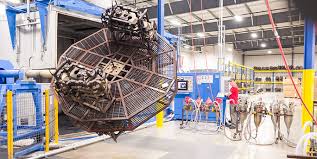Rotational molding, also known as rotomolding is a multi-faceted manufacturing process that is used to create robust, hollow plastic components. It is renowned because of its capacity to create large, complex shapes without gaps or weaknesses. This article focuses on the most important aspects of rotating molding as well as its method application, benefits, and drawbacks.
The Rotational Molding Process
Rotational manufacturing involves the heating of plastic material inside a mold which is rotated along two perpendicularly oriented axes. The primary steps of the process are as the following:
The process starts by loading granular or powdered plastic (commonly polyethylene) into an open mold. The amount of plastic used is calculated based on what thickness you want the product to have.
Heating The mold is heated by an oven. This causes the plastic to melt and coat the inside of the mold. As the mold spins, the plastic evenly coats within the mould cavity resulting in an uniform thickness of the wall.
Cooling: After heating, the mold is cool while rotating. It ensures the mold is able to solidify evenly, which reduces the risk of defects like warping or uneven thickness.
Unloading: After cooling, the mold is open, and the final part is removed. The process is able to be repeated for the production of more parts as required.
Applications of Rotational Molding
Rotational molding is a highly flexible and can be utilized in many industries. The most common applications are:
Consumer Products: Things such as play equipment and storage tanks, and coolers are often produced by the process of rotomolding.
Automobile Parts: The components such as fuel tanks and other interior parts benefit from the ability of this process to create complex shapes and lightweight structures.
Industry Equipment Rotational molding is used for producing parts like containers, bins, and large structural components.
Advantages of Rotational Molding
Design Flexibility: This process permits complex hollow shapes, without requirement for joint or assembly, thus reducing potential weak points.
Uniform Wall Thickness: Rotomolding produces parts with the same thickness of wall, which improves durability and strength.
Cost-Effective for Low to Medium Volumes: Tooling costs for rotomolding is lower in comparison to other methods such as injection molding, which makes it cost-effective for medium to small production runs.
Durability: Parts produced via rotational molding are generally immune to weathering, impacts as well as UV radiation.
Limitations of Rotational Molding
Longer Cycle Times The cooling and heating cycles of rotomolding are more lengthy when compared to injection molding, which could have an impact on the speed of production.
Size Constraints: Although molds made by rotomolding can make large parts but there are constraints to the size of the mold as well as its weight, which may affect the maximum dimensions of the final product.
Specific Materials: The variety of materials suitable for rotomolding are fewer than other methods, restricting the kinds of plastics that are able to be used.
In short Plastics Rotomolding is a flexible and cost-effective manufacturing method that can be used to create intricate, durable plastic parts. Its ability to create smooth, hollow structures makes it an ideal choice for various applications, though it does come with some limitations on cycle times as well as material options.

No Responses